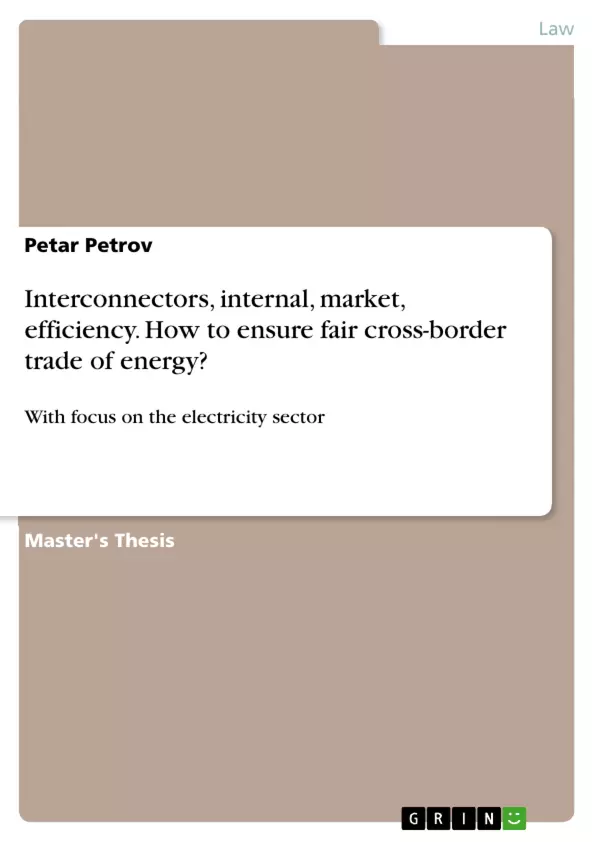The core objective of this paper is to analyse the relevance of cross-border transmission lines for competition and the achievement of a single energy market, with particular focus on the electricity sector. It aims to discuss future options for enhancing competition and achieving a real European energy market.
A common energy market even closer Union characterized by the abolition of any barriers to the four fundamental freedoms. A main barrier for creating an integrated energy market is the lack of electricity interconnections and pipelines between different Member States, between neighbouring regions and regional markets. Insufficient investment and the lack of coordination are the challenge on the path towards interconnected energy markets. Consequently, the security of energy supply of certain Member States is redoubtable.
Moreover, the existence of historical monopolies and oligopolies on the majority of national energy market and the presence of vertically integrated companies are further burdens for both market integration and competition. Indeed, competition in the energy markets is stagnating. To intensify cross-border competition, the EU advocates the extensions of cross-border transmission lines and the development of new infrastructures. Although interconnections enhance competition and are a condition sine qua non for a further energetic integration, they do not always increase energy efficiency.
Inhaltsverzeichnis (Table of Contents)
- 1. Introduction
- 2 Towards a Single Energy Market
- 2.1 The First Energy Package and the Florence Forum
- 2.2. The Liberalization of the Gas Sector and the Madrid Forum
- 2.3. Europeanization of the Energy Markets
- 2.4. Regional Energy Markets-a Main Step Forwards
- 2.5. Achieving a Single Energy Market-the Third Liberalization Package
- 3. Regulation of Cross-Border Energy Exchanges
- 3.1. Regulation of Tarifs in Cross-Border Electricity Trade
- 3.2. Congestion Management
- 3.2.1. Limitation of Transmission Capacity
- 3.2.1.1.Long-Term Capacity Reservation Agreements
- 3.2.1.2. Public Services
- 3.2.1. Limitation of Transmission Capacity
- 4. Derogations and Exemptions of Restrictive Practices
- 4.1. Small Isolated Systems in the Electricity Sector
- 4.2.Isolated Gas Markets
- 5. Efficiency and Energy Cross-Border Trade
- 5.1.The Key Importance of Interconnectors
- 5.2. The Interplay between Efficiency and Market Integration-the Swedish Interconnectors Case
- 5.3.Efficiency and Cross-Border Trade of Gas
- 6. How to Improve Energy Cross-Border Trade?
- 6.1. Investments and Subsidies
- 6.2. An Energy Infrastructure Package
- 7. Conclusion
Zielsetzung und Themenschwerpunkte (Objectives and Key Themes)
The main objective of this paper is to analyse the relevance of cross-border transmission lines for competition and the achievement of a single energy market, with a particular focus on the electricity sector. It aims to discuss future options for enhancing competition and achieving a real European energy market.
- The importance of interconnections for a functioning single energy market
- The role of competition in achieving energy market integration
- The relationship between interconnections, energy efficiency and market integration
- Potential challenges and solutions to improve energy cross-border trade
- Regulation of cross-border energy exchanges, including congestion management and tariff regulation
Zusammenfassung der Kapitel (Chapter Summaries)
- Chapter 1: Introduction: This chapter introduces the topic of the thesis and outlines the objectives and research questions. It highlights the importance of an integrated energy market and the challenges related to interconnections and market liberalization.
- Chapter 2: Towards a Single Energy Market: This chapter examines the development of the EU energy market, focusing on key milestones like the First Energy Package and the Madrid Forum. It discusses the liberalization process and the role of regional energy markets in achieving market integration.
- Chapter 3: Regulation of Cross-Border Energy Exchanges: This chapter delves into the regulatory framework for cross-border energy trade. It explores the regulation of tariffs in cross-border electricity trade and examines congestion management mechanisms. The chapter also discusses limitations of transmission capacity and the role of long-term capacity reservation agreements.
- Chapter 4: Derogations and Exemptions of Restrictive Practices: This chapter focuses on exceptions to the general principles of market liberalization. It analyzes the specific cases of small isolated systems in the electricity sector and isolated gas markets.
- Chapter 5: Efficiency and Energy Cross-Border Trade: This chapter examines the relationship between interconnectors and energy efficiency. It discusses the key importance of interconnectors for market integration and explores the interplay between efficiency and market integration using the Swedish interconnectors case study. The chapter also examines the impact of cross-border trade of gas on energy efficiency.
- Chapter 6: How to Improve Energy Cross-Border Trade?: This chapter focuses on practical solutions for enhancing cross-border energy trade. It discusses the importance of investments and subsidies, and proposes the development of an Energy Infrastructure Package.
Schlüsselwörter (Keywords)
This thesis explores the complex relationship between cross-border transmission lines, competition, and the achievement of a single energy market, with a specific focus on the electricity sector. The main keywords and focus topics include interconnectors, internal energy market, market integration, congestion management, energy efficiency, transmission capacity, and third-party access.
- Quote paper
- Petar Petrov (Author), 2015, Interconnectors, internal, market, efficiency. How to ensure fair cross-border trade of energy?, Munich, GRIN Verlag, https://www.grin.com/document/1163228



